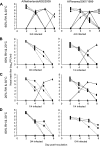Transmission of a 2009 pandemic influenza virus shows a sensitivity to temperature and humidity similar to that of an H3N2 seasonal strain
- PMID: 21084485
- PMCID: PMC3020521
- DOI: 10.1128/JVI.02186-10
Transmission of a 2009 pandemic influenza virus shows a sensitivity to temperature and humidity similar to that of an H3N2 seasonal strain
Abstract
In temperate regions of the world, influenza epidemics follow a highly regular seasonal pattern, in which activity peaks in midwinter. Consistently with this epidemiology, we have shown previously that the aerosol transmission of a seasonal H3N2 influenza virus is most efficient under cold, dry conditions. With the 2009 H1N1 pandemic, an exception to the standard seasonality of influenza developed: during 2009 in the Northern Hemisphere, an unusually high level of influenza virus activity over the spring and summer months was followed by a widespread epidemic which peaked in late October, approximately 2.5 months earlier than usual. Herein we show that aerosol transmission of a 2009 pandemic strain shows a dependence on relative humidity and temperature very similar to that of a seasonal H3N2 influenza virus. Our data indicate that the observed differences in the timings of outbreaks with regard to the seasons are most likely not due to intrinsic differences in transmission between the pandemic H1N1 and seasonal H3N2 influenza viruses.
Figures

Similar articles
-
Transmission of pandemic H1N1 influenza virus and impact of prior exposure to seasonal strains or interferon treatment.J Virol. 2010 Jan;84(1):21-6. doi: 10.1128/JVI.01732-09. J Virol. 2010. PMID: 19828604 Free PMC article.
-
Guinea pig model for evaluating the potential public health risk of swine and avian influenza viruses.PLoS One. 2010 Nov 23;5(11):e15537. doi: 10.1371/journal.pone.0015537. PLoS One. 2010. PMID: 21124850 Free PMC article.
-
Environmental Persistence of Influenza Viruses Is Dependent upon Virus Type and Host Origin.mSphere. 2019 Aug 21;4(4):e00552-19. doi: 10.1128/mSphere.00552-19. mSphere. 2019. PMID: 31434749 Free PMC article.
-
[Swine-origin influenza H1N1/California--passions and facts].Zh Mikrobiol Epidemiol Immunobiol. 2010 Jul-Aug;(4):105-14. Zh Mikrobiol Epidemiol Immunobiol. 2010. PMID: 20795393 Review. Russian.
-
[Transmissibility and pathogenicity of influenza viruses].Nihon Rinsho. 2010 Sep;68(9):1616-23. Nihon Rinsho. 2010. PMID: 20845737 Review. Japanese.
Cited by
-
The M segment of the 2009 pandemic influenza virus confers increased neuraminidase activity, filamentous morphology, and efficient contact transmissibility to A/Puerto Rico/8/1934-based reassortant viruses.J Virol. 2014 Apr;88(7):3802-14. doi: 10.1128/JVI.03607-13. Epub 2014 Jan 15. J Virol. 2014. PMID: 24429367 Free PMC article.
-
Climate change and influenza: the likelihood of early and severe influenza seasons following warmer than average winters.PLoS Curr. 2013 Jan 28;5:ecurrents.flu.3679b56a3a5313dc7c043fb944c6f138. doi: 10.1371/currents.flu.3679b56a3a5313dc7c043fb944c6f138. PLoS Curr. 2013. PMID: 24045424 Free PMC article.
-
Effects of temperature variation and humidity on the death of COVID-19 in Wuhan, China.Sci Total Environ. 2020 Jul 1;724:138226. doi: 10.1016/j.scitotenv.2020.138226. Epub 2020 Mar 26. Sci Total Environ. 2020. PMID: 32408453 Free PMC article.
-
Detection of influenza A virus in aerosols of vaccinated and non-vaccinated pigs in a warm environment.PLoS One. 2018 May 21;13(5):e0197600. doi: 10.1371/journal.pone.0197600. eCollection 2018. PLoS One. 2018. PMID: 29782527 Free PMC article.
-
Global evidence for ultraviolet radiation decreasing COVID-19 growth rates.Proc Natl Acad Sci U S A. 2021 Jan 7;118(1):e2012370118. doi: 10.1073/pnas.2012370118. Proc Natl Acad Sci U S A. 2021. PMID: 33323525 Free PMC article.
References
-
- Centers for Disease Control and Prevention. April-May 2010. FluView: a weekly influenza surveillance report prepared by the influenza division. Centers for Disease Control and Prevention, Atlanta, GA. http://www.cdc.gov/flu/weekly/. Accessed 25 September 2010.
-
- Housworth, J., and A. D. Langmuir. 1974. Excess mortality from epidemic influenza, 1957-1966. Am. J. Epidemiol. 100:40-48. - PubMed
Publication types
MeSH terms
Substances
Grants and funding
LinkOut - more resources
Full Text Sources
Medical

